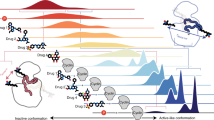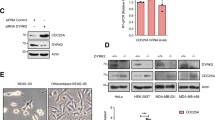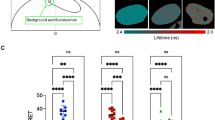Abstract
We previously reported that cdk2 phosphorylates two serine residues near the DNA-binding domain of the YA subunit of NF-Y transcription factor and this phosphorylation is essential for DNA binding of NF-Y. In this study, we examined the effects of a phosphorylation-deficient mutant form of YA, YA-aa, in which the two serine residues are replaced with alanine, on the cell cycle and expression of the NF-Y target genes. Transient transfection assays show that YA-aa inhibits transcription from the NF-Y target promoters, such as cdc2, cyclin A, and cdc25C. Moreover, this inhibitory function of YA-aa can be suppressed by the expression of wild-type YA, implying that YA-aa inhibits transcription of those NF-Y target genes by inactivating wild-type YA. Since NF-Y target genes include the cell cycle-regulatory genes that ensure orderly progression of the cell cycle, we examined the effects of YA-aa in cell cycle progression. We constructed a recombinant adenovirus encoding YA-aa and found that YA-aa expression leads to repression of cell cycle-regulatory genes, such as cyclin A, RNR R2, DNA polymerase α, cdc2, cyclin B, and cdc25C. Consistently, YA-aa expression results in the inactivation of both cdc2 and cdk2. Furthermore, cell cycle analysis reveals that YA-aa induces cell cycle arrest at both G1 and G2/M. These results suggest that cdk2-dependent phosphorylation of NF-Y is essential for the expression of the cell cycle-regulatory genes and therefore for cell cycle progression at both G1/S and G2/M.
This is a preview of subscription content, access via your institution
Access options
Subscribe to this journal
Receive 50 print issues and online access
$259.00 per year
only $5.18 per issue
Buy this article
- Purchase on SpringerLink
- Instant access to full article PDF
Prices may be subject to local taxes which are calculated during checkout




Similar content being viewed by others
References
Baxevanis AD, Arents G, Moudrianakis EN and Landsman D . (1995). Nucleic Acids Res., 23, 2685–2691.
Bunz F, Dutriaux A, Lengauer C, Waldman T, Zhou S, Brown JP, Sedivy JM, Kinzler KW and Vogelstein B . (1998). Science, 282, 1497–1501.
Currie RA . (1998). J. Biol. Chem., 273, 18220–18229.
Dorn A, Bollekens J, Staub A, Benoist C and Mathis D . (1987). Cell, 50, 863–872.
Duronio RJ, Brook A, Dyson N and O'Farrell PH . (1996). Genes Dev., 10, 2505–2513.
Farina A, Manni I, Fontemaggi G, Tiainen M, Cenciarelli C, Bellorini M, Mantovani R, Sacchi A and Piaggio G . (1999). Oncogene, 18, 2818–2827.
Gerrish K, Cissell MA and Stein R . (2001). J. Biol. Chem., 276, 47775–47784.
Graham FL and van der Eb AJ . (1973). Virology, 54, 536–539.
Guadagno TM and Newport JW . (1996). Cell, 84, 73–82.
Hu Q and Maity SN . (2000). J. Biol. Chem., 275, 4435–4444.
Jung MS, Yun J, Chae HD, Kim JM, Kim SC, Choi TS and Shin DY . (2001). Oncogene, 20, 5818–5825.
Li XY, Hooft van Huijsduijnen R, Mantovani R, Benoist C and Mathis D . (1992). J. Biol. Chem., 267, 8984–8990.
Maity SN and de Crombrugghe B . (1998). Trends Biochem. Sci., 23, 174–178.
Manni J, Mazzaro G, Gurtner A, Mantovani R, Haugwitz U, Krause K, Engeland K, Sacchi A, Soddu S and Piaggio G . (2001). J. Biol. Chem., 276, 5570–5576.
Mantovani R . (1998). Nucleic Acids Res., 26, 1135–1143.
Marziali G, Perrotti E, Ilari R, Coccia EM, Mantovani R, Testa U and Battistini A . (1999). Blood, 93, 519–526.
Marziali G, Perrotti E, Ilari R, Testa U, Coccia EM and Battistini A . (1997). Mol. Cell. Biol., 17, 1387–1395.
Matuoka K and Yu Chen K . (1999). Exp. Cell Res., 253, 365–371.
Morgan DO . (1995). Nature, 374, 131–134.
Ohtani K, DeGregori J and Nevins JR . (1995). Proc. Natl. Acad. Sci. USA, 92, 12146–12150.
Pang JH and Chen KY . (1993). J. Biol. Chem., 268, 2909–2916.
Park M, Chae HD, Yun J, Jung M, Kim YS, Kim SH, Han MH and Shin DY . (2000). Cancer Res., 60, 542–545.
Park JS, Kim EJ, Park TC, Kim EJ, Kim J, Lee JM, Namgoong SE and Um SJ . (2001). Cancer. Res. Treat., 33, 236–242.
Schreiber M, Muller WJ, Singh G and Graham FL . (1999). Oncogene, 18, 1663–1676.
Sinha S, Kim IS, Sohn KY, de Crombrugghe B and Maity SN . (1996). Mol. Cell. Biol., 16, 328–337.
Yun J, Chae HD, Choi TS, Kim EH, Bang YJ, Chung JK, Choi KS, Mantovani R and Shin DY . (2003). J. Biol. Chem., 278, 36966–36972.
Yun J, Chae HD, Choy HE, Chung J, Yoo HS, Han MH and Shin DY . (1999). J. Biol. Chem., 274, 29677–29682.
Zwicker J, Lucibello FC, Wolfraim LA, Gross C, Truss M, Engeland K and Muller R . (1995). EMBO J., 14, 4514–4522.
Acknowledgements
We thank Dr K Homma for critical reading of the manuscript. This work is supported, in part, by the National Research Laboratory Program of the Korean Ministry of Science and Technology (DYS and YJB), the Molecular Aging Research Center (DYS), and research fund of Dankook University 2002.
Author information
Authors and Affiliations
Corresponding author
Rights and permissions
About this article
Cite this article
Chae, HD., Yun, J., Bang, YJ. et al. Cdk2-dependent phosphorylation of the NF-Y transcription factor is essential for the expression of the cell cycle-regulatory genes and cell cycle G1/S and G2/M transitions. Oncogene 23, 4084–4088 (2004). https://doi.org/10.1038/sj.onc.1207482
Received:
Revised:
Accepted:
Published:
Issue date:
DOI: https://doi.org/10.1038/sj.onc.1207482
Keywords
This article is cited by
-
MeCP2 facilitates breast cancer growth via promoting ubiquitination-mediated P53 degradation by inhibiting RPL5/RPL11 transcription
Oncogenesis (2020)
-
Association of p21 with NF-YA suppresses the expression of Polo-like kinase 1 and prevents mitotic death in response to DNA damage
Cell Death & Disease (2014)
-
Recovery from a DNA‐damage‐induced G2 arrest requires Cdk‐dependent activation of FoxM1
EMBO reports (2010)
-
Deregulation of Cdk2 causes Bim-mediated apoptosis in p53-deficient tumors following actin damage
Oncogene (2008)
-
Overload of the heat-shock protein H11/HspB8 triggers melanoma cell apoptosis through activation of transforming growth factor-β-activated kinase 1
Oncogene (2007)



